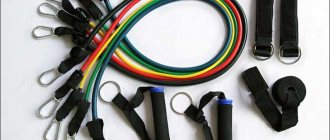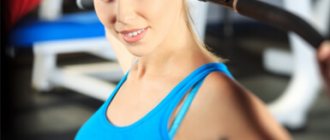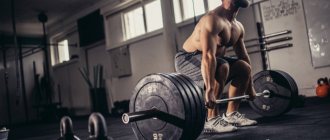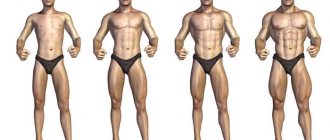Training programsCardio training
Swim your distance to the swimmer's elastic and toned body, and let everyone else beg you to put on a swimsuit.
Author:
C.J. Souver
Swimming is a form of exercise that is rarely thought of, and if your gym membership includes access to the pool, why not take advantage of it? Yes, yes, I know this may sound a little scary. Styles, technique, equipment, etiquette, timing and intensity - swimming has its own set of rules and strategies.
However, all this fades into the background when you think about the ideal swimmer's body with a chiseled silhouette! It is elastic, toned, strong and graceful. This is exactly the type of build that many people strive to achieve. Not skinny, not massive, but combining everything you need. Plus, swimming is one of the best forms of cardio you can find—by being submerged in water, your entire body gets a resistance workout.
So why not dive into the water and come out with a more attractive figure? It doesn't take much to get started, and I'll give you the information you need to hit the pool today!
Swimming set
You wear certain clothes and use special equipment when you lift weights or run. The same is true for swimming:
Glasses
Chlorine in water is really a nuisance. You don't want people to wonder why your eyes are red. Plus, the glasses look great! Their cost ranges from 150 to 1500 rubles.
Swimming suit
I like body-hugging swim trunks, but if you're more conservative, regular shorts will work. For women, a special swimsuit will be better than a bikini, however, the choice is yours. The price range is very wide, so find what suits you!
Swimboard
Many pools have such boards, but you can buy your own for about 150 to 900 rubles. A swimboard is used to isolate the lower part of your body.
Kolobashka (figure eight float) or floating dumbbells
Gyms with a swimming pool usually have such devices, but you can buy your own for 200 rubles. The bun is used to isolate the upper half of the body.
Fins (optional)
You never know if the pool has fins for free use. So be prepared to buy your own, spending from 400 to 1500 rubles.
Waterproof watch (optional)
They are very useful for checking the time while sailing. You don't need something very expensive and fashionable - you can find an excellent pair with a stopwatch for 800-1000 rubles.
Life jacket or aqua belt
Many gyms with swimming pools have such equipment. The cost of each item ranges from 160 to 1000 rubles. You can use them for swimming at the end of your workout.
Bathing cap (optional)
Uncollected hair in the pool causes certain inconvenience. The cap costs from 250 to 700 rubles.
Exercises for injuries
Swimming improves health and has a positive effect on the recovery process for various injuries, which is why it is recommended in the treatment of spinal injuries, meniscus tears, limb fractures, and many other types of injuries.
If you have had an injury, then before going to the pool for the first time, you should consult a doctor and get his recommendations..
Rehabilitation after injury involves gradual adaptation to the water. As a general rule, it is recommended to start with 20-30 minutes of simple exercises and gradually progress to more complex workouts.
Hernia
Here is a good description of how to swim with a herniated disc:
Spinal injury
Similarly, here is a variation of the exercise for spinal injury:
Possible lesson plan
If you have previously been involved in swimming and have an injury, here is an example of a possible workout for scoliosis or spinal hernia (check with your doctor about its admissibility in your case!) :
- 15-20 simple immersions in water while inhaling and exhaling;
- 200 meters backstroke with two arms;
- 100 on the back with alternate arms thrown;
- 300 breaststroke with separate arms and legs;
- 200 crawl with breathing after 2 strokes;
- 200 butterfly;
- 15-20 simple immersions in water while inhaling and exhaling.
Pool etiquette
Have you ever encountered a situation where someone in the gym takes your bench or exercise machine? This is infuriating; and when meeting discourteous swimmers in the pool, a desire arises to drown them. Follow the rules below and don't risk your own life.
Choose a lane that suits your swimming speed
You don't want anyone to have to swim slower because of you, and you also don't want to have to slow down yourself. So to be comfortable, find a lane that suits your swimming speed.
Always ask or warn the swimmer that you want to share the lane with him
It's not very polite to invade someone else's space at the pool. But when it's crowded, swimmers have to share lanes. Typically the maximum number of swimmers in one lane is three. And don't try to share a lane if there is only one other person in the pool besides you. This is just ridiculous.
When asking about the possibility of sharing the same path, agree on how you will share it
You can either swim in circles one after the other, like on a race track, or split the lane into two halves down the middle and stay on your side. Make sure you and your partner understand each other correctly!
Now everything looks great, but a head-on collision is only a matter of time.
Be mindful of other swimmers in your lane
If you need to rest or feel like you are about to be overtaken, stop at the end of the path rather than in the middle. For safety reasons, always keep an eye on where your partner is when swimming.
Keep talking to a minimum
It just infuriates me when someone in the gym tries to tell me about their life, and in the pool this situation is even more terrible. We all have places to rush to, exercises to complete. Close your mouth and swim.
How to increase crawl speed
Wayne Goldsmith - famous American swimming coach
Here are five recommendations for increasing speed from Wayne Goldsmith:
- Reducing the time between swimming with your usual style and on your feet (Killer Kick Set).
Consists of two parts:- Finding the speed limit - to do this, you need to swim 50 meters in style and add 15 seconds , then swim this distance on your feet in less total time, after which you should subtract one second at a time and try to swim out of the set time .
When the swimmer touches the side at exactly the set time, the limit will be reached.
Training at the speed limit - swim 8 x 50 on your feet at the established speed limit, allotting two minutes for each segment with a break.
- Finding the speed limit - to do this, you need to swim 50 meters in style and add 15 seconds , then swim this distance on your feet in less total time, after which you should subtract one second at a time and try to swim out of the set time .
- Improving times with shorter distances (Over/Under Set) . The point is to overcome the best old time indicator by dividing the training into shorter segments, gradually reducing the time for each distance.
- Stroke increase combination (8-10-12-14-16). The idea is to do a certain number of powerful strokes at the start, then swim the segment at a slower pace. Following this combination, the swimmer must do:
- in the first segment - 8 powerful strokes and a calmer pace until the end;
- on the second segment - 10 and then, as on subsequent segments, similarly more calm;
- on the third segment – 12
- on the fourth – 14;
- on the fifth – 16;
- 100-200 meters cool down.
- Competitive exercise in pairs (Dive Cones) . The idea is to cover a larger distance in a specified period of time. That is, the swimmer’s goal is to swim a set number of segments in less time than the opponent. As stated sets, you can take 5 segments of 10 seconds, 4 of 15, 3 of 20, 2 of 25.
- Overcoming segments of 60 meters at maximum speed (Super Sixties) . This distance is considered the best for developing the speed qualities of a swimmer. As a training program, you can use the 6 to 60 option with relaxing swimming between speed segments.
It is recommended to repeat the program a couple of times, and you can choose the combination of strokes yourself.
Achieving the goal
The intensity of a swimming workout depends largely on one variable—your heart rate (HR). This is the same as pulse and is measured in beats per minute (BPM). To lose weight, we want to stay within our maximum effective heart rate. How to calculate it?
- First we will need your maximum heart rate (MHR). To find your MHR, subtract your age from 220.
- Multiply your MHR by 0.85 to get your maximum target heart rate (Max HR).
- Multiply your MHR by 0.75 to get your average target heart rate (Avg THR).
- Multiply your MHR by 0.65 to get your minimum target heart rate (Min HR).
In order for the workout to be most effective, and at the same time burn the maximum number of calories, swimming will require you to comply with the last three values during different segments of the workout. It is necessary that your heart rate does not exceed the Max Central Heart Rate (otherwise it will be too severe a regime) and not be lower than the Min Central Heart Rate (which will correspond to an insufficiently severe regime).
Your workout will be structured so that you can periodically measure your heart rate during rest periods.
To find out your heart rate right now, place 2 fingers on the carotid artery and count your pulse for 30 seconds. To get the desired value, multiply this number by 2.
Average level
Breath control and endurance
Distance – 900 meters, freestyle training:
- warm-up 2 x 100 meters with one break in the middle;
- 4 x 25 fast crawl with 30 seconds rest between segments;
- 4 x 50 with three strokes on each stroke and a 15-second rest after every 50 meters;
- 4 x 25 fast with holding your breath during the segment and a 30-second rest after;
- 4 x 50 with three strokes on each stroke and a 15-second rest after each half hundred;
- cool down 100 meters.
All styles
Distance – 900 meters, plan:
- warm-up with crawl 2 x 100 with rest at your discretion;
- 4 x 25 on the back with breaks of 15 seconds;
- 4 x 25 breaststroke with breaks;
- 4 x 25 butterfly with breaks;
- 2 100 in turn - 25 in each style with a break of 30 seconds after a hundred;
- cool down with freestyle 200 meters.
Krol + complex
Distance – 1000 meters, plan:
- warm-up 200 without a break;
- 4 x 50 freestyle with alternating speeds every 25 meters and resting for 15 seconds;
- 4 x 100 alternately - 25 meters in each style with a break of 30 seconds after a hundred;
- cool down 200 meters.
Krol + complex No. 2
Distance – 1000 meters, plan:
- warm-up with freestyle 100 meters without a break;
- 4 x 50 alternately butterfly and crawl every 25 meters and a 30-second break after every 50 meters;
- 4 x 50 – back and crawl;
- 4 x 50 – breaststroke and crawl;
- 4 x 50 freestyle with alternating speeds every 25 and rest;
- 100 meter freestyle cool down.
Endurance, breathing rhythm, turning technique
Option 1
Distance – 1200 with added turns, plan:
- warm-up crawl 300 meters without rest;
- 4 x 50 freestyle with alternating breathing - inhaling on the 4th stroke in the first 25 meters and on the 2nd stroke in the next 25 meters with a rest of 15 seconds;
- 200 freestyle followed by 10 turns after every second stroke;
- 4 x 50 in any style at your discretion with a break;
- 300m freestyle cool down.
Option 2
Distance – 1200 with added turns, plan:
- warm-up crawl 200 without rest;
- 200 freestyle followed by 4 turns after every fourth stroke;
- 4 x 100 freestyle, inhaling on the fourth stroke and resting 15 seconds after the segment;
- 4 turns after every fourth stroke;
- 4 x 50 in any style at your discretion with a short break;
- cool down 200 meters freestyle.
Useful tips
When starting your training, think through all the points and listen to the advice of experts. Choose a place where you will study. In any case, you will need to overcome your fear of water, otherwise you will never learn to swim confidently.
How not to be afraid of water?
There are plenty of ways to ease your fears of water. Some beginners are afraid to dive, others panic, fearing the depths. There are many exercises that help you “make friends” with water.
How to get rid of fears:
- Don't rush to go deep. It is contraindicated for a beginner. Start with the pool - you will feel safer there than in open water.
- Don't force things. Get used to the water before swimming. Learn to stick with it. Perform a set of exercises to help you feel the buoyant force of water - “star” and “float.”
- Swim with insurance. In the first lessons, a board or armbands will help you.
The most difficult moment in learning to swim is overcoming the psychological barrier. If you eliminate it, everything will be simpler. You will be able to concentrate on practicing the technique without being distracted by fighting your own fears.
Where is the best place to study?
In open water, beginners feel insecure. They are afraid of depth, shy of unnecessary glances and ridicule. A beginner is much more comfortable in the pool.
Benefits of training in the pool:
- safety;
- the presence of paths, belays, handrails and other attributes that help learning;
- the ability to perform any exercise;
- absence of currents, whirlpools, large and unpredictable depths.
If you study in open water, it has to be the sea. It contains salt water, which holds the human body much better than fresh water.
What kind of warm-up is needed?
Like any physical activity, swimming is recommended to be preceded by a warm-up. They start it on land and continue in the water.
Warm-up begins with simple movements - doing various swings. Gradually move on to more complex exercises - rotations - increasing amplitude and intensity. After warming up, muscles become more elastic and mobile, reducing the risk of strain.
Exercises on land:
- Walking, then running, jumping. Execution time – 2 minutes. The body warms up and becomes ready for subsequent loads.
- Head turns. This exercise is aimed at working the neck. After it, all the vertebrae fall into place.
- Scrolling your hands in different directions. Train your wrists.
- Rotation of arms at elbows. The exercise develops the elbow joints.
- Wave your arms. Development of shoulder joints. Exercise relieves tension and prevents injury.
- Rotation of the pelvis. Development of the hip department.
- Squats and knee rotations. Such movements train the calf muscles and develop the knee joints.
- Ankle rotation. The exercise is performed by resting your toes on the floor or holding them in the air.
The warm-up is completed with static and dynamic exercises. Improving flexibility helps stretch muscle fibers, which increases strength and endurance.
After warming up on land, move on to exercises in the water. They adapt the swimmer to the aquatic environment and help prepare for classes taking into account their well-being. There is no standard water warm-up program, but there are basic exercises recommended for use.
Exercises in water:
- Calm sailing. The movements are unhurried. Arms, legs, head and body practice technique.
- Exercises that involve only the arms or legs. Strokes are performed in a minimal amount.
- Movements that improve coordination of all parts of the body and swimming technique.
- Breathing training. He is detained during the dive and during the swim.
- Move short distances at average speed.
- Swimming to restore heart function and respiratory function.
The distance a swimmer swims during warm-up depends on his physical fitness. On average, it is 200-800 m. The set of exercises and their intensity are also affected by the state of the nervous system.
Slip
The sliding technique is the main one in this sport, the starting position of a novice swimmer. He pushes off the side with his feet and begins the exercise. The body is tense while sliding, the limbs are extended to the maximum, the toes are pulled back. The head lies between outstretched arms, breathing is carried out into the water. Then the same movements are repeated while lying on your stomach. In the initial stages, sliding is better achieved with the help of a foam board.
During the exercise, try to avoid basic mistakes. Among them: incomplete straightening of the torso: limbs not straightened forward enough, head bowed too far and eyes closed.
Having achieved clear gliding and covering a distance, which should be at least 2 m without the participation of limbs, you can proceed to connecting movements with your legs and arms.
Content
- 1 Balance between different types of physical training 1.1 Planning classes
- 1.2 How will this or that series improve my performance?
- 5.1 Recommended lesson plan










